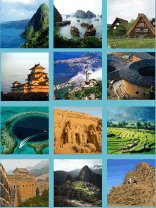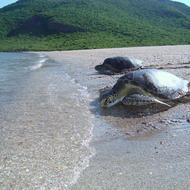Guide 5: Communicating with visitors
What this guide will tell you:
This guide will tell you why communicating with visitors matters, and how you can do it effectively, in a culturally appropriate manner.
Steps to success:
- Why this matters
-
Making tourism more sustainable means changing the way that tourism happens at a destination. Some of this will be about infrastructure, but a great deal of it is about influencing the choices that businesses, communities, and visitors make. We believe that to make tourism more sustainable, you need to become effective at communicating with visitors, and that, in turn, means you need to enlist the help of tourism businesses and the host community.
-
 Have a clear script for the destination to follow and key messages that everyone will understand
Have a clear script for the destination to follow and key messages that everyone will understand -
Identify what heritage professionals, individuals in the tourism sector, and the host community want (and need) visitors to know about your destination – this means working out what your story is and what OUV looks like at your destination. This needs to be clear, concise, and accessible. It should not be academic, technical, and obtuse, but it should also not be overly simplistic.
If you have the resources, then develop a communications strategy that identifies key audiences and objectives. You can either help shape the interpretation of your site and the wider destination, or commission someone else to do it. Great World Heritage sites have developed simple and accessible OUV narratives. For example, the Wadden Sea WHS explains some of its key species to children and visitors through the 'Small Five in the Wadden Sea' project, which involves a simple story, explanation, and 'small five safaris' in a way people can experience and learn about the species that make its ecosystem work.
Clarity in communication is crucial. The best destinations analyse how to make their stories work in the different spaces within the destination – from airports and railways stations to hotel rooms or the public realm. An overarching interpretation strategy is often helpful to steer visitors through the destination and encourage them to learn. It also needs to encourage them to return, believing either the story is repeatedly freshened over time, or that it is so rich, they will have an entirely new experience each time they visit.
Identify those stakeholders involved in the marketing for the destination and partner with them. In most cases, the destination will already have marketing professionals and a marketing budget, so it is crucial to influence that process to ensure that marketing communication helps bring about the sustainable tourism objectives in the strategy (See Guide 1 and Guide 2). Sustainable tourism communication starts the moment consumers select their choice of destination and lasts after they return home. It is often too late to influence choices if you wait for them to arrive at the site, as expectations will already have been set. Sustainable tourism requires visitors to understand the value, distinctiveness, and authenticity of the site, as well as alter their attitudes and behaviour to reflect this.
Make it clear to potential visitors that the world’s most important historic places offer amazing experiences, but tourism in these places is not a ‘free-for-all.’ There are limits and certain behaviours that are simply not appropriate for heritage or the host community (see e.g. case study ‘The Impact of Tourism on the Monks of Luang Prabang’). Raising awareness can be done in such a way that visitors accept the constraints as part of a unique once-in-a-lifetime experience.
Be clear about your access policy:
- Are you open for visitors to come whenever they like? Make sure any restrictions are clear.
- Do they need a ticket? Tell them so in advance.
- Do you only want overnight visitors? Create systems that enable this and discourage day visits.
The policy needs to be appropriate for the site, the local tourism sector, and the community. It should also be thought through and properly communicated. If not, there becomes a lazy assumption that all tourism is good tourism.
Be careful not to trap communities through idealized marketing. This can lead to surprise and disappointment when visitors experience the day-to-day realities of local lives. It is important when marketing World Heritage sites that you communicate not just the joy of visiting, but something of the social, cultural, and environmental realities of the present day.
-
 Ensure that tourism marketing of the destination uses the potential added value of World Heritage Status
Ensure that tourism marketing of the destination uses the potential added value of World Heritage Status -
There is a growing body of evidence suggesting that World Heritage is a powerful brand for attracting cultural tourists from both the domestic and international markets, including people who might otherwise have ignored the destination. These cultural tourists spend more, stay longer, and are more likely to care about sustainability, OUV, and the host culture. Incorporating UNESCO branding might be an opportunity for some destinations to change the visitor profile in ways that aid sustainable development.
Segmentation of the visitor market is crucial. All tourists are not equal in their ecological or cultural footprint, nor in their economic impact. Some types of visitors will have a much greater ecological and cultural footprint than others, while some will also yield significantly more revenue. Seek to communicate with the segments of the market that fit with your destination’s strategy. This may mean fewer visitors, but with greater economic benefit.
Make sure tourism businesses understand the potential value of highlighting UNESCO World Heritage Status in their marketing, and work together to help them become more sustainable businesses that play an active role in the sustainable management of tourism. Some sites, for example Vigan in the Philippines, have provided training for businesses so they can understand the potential benefit and OUV of the site.
Ensure that marketing professionals at the destination understand that communicating about the site has to be strategic and encourage sustainability. Marketing must deliver a return on investment, but it can also spread important messages about the destination and build relationships with visitors crucial to fundraising or other activities of strategic value. It is not just about selling holidays. It is essential that you are able to show the tourism sector that promoting sustainability is simply part of doing high quality tourism, rather than a painful obligation.
-
 Make understanding the site easy
Make understanding the site easy -
It is important to bring together the key information about the site into one accessible form or place. Good interpretation is an obligation of being a World Heritage site. Visitors must be able to find the practical information they need easily, in a language they can read, and in a way they can access from their own homes. At its simplest, this usually means some form of website and social media.
Every World Heritage site should have, at the very least, a basic website. However, surprisingly few World Heritage sites have a website available in language visitors can easily find via a simple Web search. If you want to maximize your ability to speak to visitors, then you need to mainstream sustainability – make it part of how people learn about the basics of the destination. Dynamic destination websites offer information on the full range of things people need, including transport, accommodation, food and drink, retail, leisure, and information on the local community and culture. Website templates are now readily available in most parts of the world at little or no cost, and simply being a World Heritage site will drive traffic in significant numbers.
The story needs to be as accessible as possible, even for those wishing to experience things remotely. By using the full range of media, people who may not be able to access one kind of interpretation have the opportunity to learn in other ways. Be aware that a significant number of interested people may have physical or visual impairments that may limit their enjoyment of the site, so offer alternatives. Many people may wish to learn about and engage with the heritage values of the site without actually visiting, so make your online presence as good as it can be. All this will contribute to the ‘word of mouth’ marketing of your site.
Developing ground rules or a code of conduct in collaboration with conservation experts, tourism sector professionals, and the host community can be a valuable activity – it engages stakeholders in a meaningful discussion about what is and what is not appropriate behaviour in the destination. Many visitors are relieved to have the social and cultural customs of the host community explained, as well as being aware how they might inadvertently damage the site. The key point you must realize is that codes of conduct are only as good as their communication. The temptation is to write long lists that are printed as pamphlets, but this has limited effect. Instead, try developing a very simple five-point code of conduct and turn local people into the communicators. For example, every taxi could have the five points of good behaviour prominently displayed in its interior.
Provide the simple information visitors need, such as how to navigate the site and the different attractions that exist. Do not forget to provide a basic map. This fulfils two key functions:
- It helps visitors orientate themselves
- It can also offer suggestions to improve the experience and lessen the negative impacts of their visit.
Making information available in the languages (written or visual) visitors speak is, of course, also very important.
Help visitors make sustainable transport and accommodation choices before they arrive. Use the websites that visitors go to before they visit to share your offer, communicate the progressive alternatives, and identify what the benefits of using them might be.
- Are they cheaper?
- Do they provide a better or unique experience?
- Are they more responsible, more interesting, or bring benefits to local people more effectively?
Give people reasons to be good.
Avoid text-heavy interpretation boards as a go-to solution. The world is changing, and text heavy interpretation can be inaccessible for many global visitors because of language barriers. There is a place for interpretation boards, yes, but many museums and visitor attractions are moving away from this approach. Instead, they are telling the story more creatively across the site, through people rather than written interpretations. Many sites will have an excellent network of guides who play a critical role in interpretation and storytelling – work with guiding organizations to ensure they have the necessary training and accreditation to do the job well.
Mainstream sustainability into the destination’s communication. If key sustainability messages are embedded into the interpretation, then the number of visitors you can reach with this concept is maximized. The last thing you want to happen is fragmentation of the information into multiple locations, with key messages getting lost in the noise. Having distinctiveness, authenticity, and sense of place are key marketing assets for destinations.
Use your World Heritage site status to draw the media's attention, and then work with them to get key messages out to the wider public. This means providing the media with suitable stories and collaborating with them to shape the narrative by writing press releases, etc.
Work with others to create ‘package’ experiences. There is a growing market for people wishing to experience World Heritage sites in a unique way, or to pursue niche interests. By working with other sites in the same region, or with other thematically linked sites, you can appeal to visitors who may wish to understand and visit your site as part of a wider itinerary.
-
 Be creative – communicate through everything, throughout the whole life-cycle of the visitor experience
Be creative – communicate through everything, throughout the whole life-cycle of the visitor experience -
By the time visitors arrive in your destination, it may be too late to shape their itinerary and their perceptions of what they can and cannot do at the destination – make sure you get your key messages to them through tourism brochures, booking websites, or the various other media visitors will use before their trip. This is another reason why stakeholders need to work together. ‘Tourism’ often starts months before an actual visit (e.g. through online research) and continues through travel, time in the destination itself, and after the trip. As people go home, they may wish to learn more about the site, its heritage, and its OUV. Being able to sustain interest and contact post-visit is key to some strategic goals, such as fundraising. Increasingly, people are online in airports, on trains, and in vehicles, so being able to communicate with them in those places has value.
Work out how to use your storytelling and interpretation facilities to best effect. Good World Heritage destinations ensure that different museums and visitor centres all tell complementary, but different elements of the site’s story. For instance, the interpretation scheme of Hadrian’s Wall, England, explores different elements of Roman life at different points across the Wall. Museums and visitor centres within a destination should be supported to see themselves as mutually beneficial aspects of the same destination. They should be encouraged to work together to widen the stories that can be told and deepen the visitor experience.
Some destinations do benefit from having a defined visitor interpretation centre or storytelling hub, but many people mistakenly think that an interpretation centre is all that a site needs and overstate the importance of the built facilities. Often, there are other ways to communicate the OUV and key messages. Ask yourself whether you want to have a small percentage of your visitors going to a dedicated museum about the OUV of the site, or have a large percentage of visitors leaving the destination with a basic understanding of the key narrative. If you want almost all visitors to learn something, then you will need to communicate through more than just a visitor centre.
Communication does not start and stop in the World Heritage site. If you do not utilize the entire destination, you are missing huge opportunities to influence and bring about strategic shifts to behaviour and understanding. Research suggests that no more than 10% of short holidays are spent in museums and galleries – that’s 90% of the holiday experience that can be lost as moments to communicate. Work with businesses and the host community to identify opportunities for communicating key messages to visitors. Some destinations now do amazing things by communicating with visitors in airports and railways stations, in hotel rooms, in bars and restaurants, and through clever approaches to interpretation and storytelling, running through the entire visitor experience. Think about what you would like visitors to understand, and what practical things they need to know in order to make sustainable choices. Then, find creative and inspired ways to reach them. It does not have to be complicated. It can be through the most humble of media – for example, displaying the explanation of OUV on a tablecloth in a restaurant or on the wall of a restroom.
Identify the best media for reaching the majority of visitors, use it, and be creative! Visitors are not obliged to listen to you. It is a choice, and you will most likely have to compete with and overcome many other sources of information bombarding them. The only measure of whether communication works is whether people get the message and act upon it. Some destinations do amazing things with low tech and low cost solutions, such as turning taxi drivers of the destination into explainers of OUV or new technologies like mobile phone apps. Many of the social media platforms such as Facebook, Twitter, or Linkedin are essentially free to the user. Think simple as well as technological –everything from guide ropes, to flooring where people queue, airport walls, literature in hotel rooms, and beer mats can be used. Written guidance can be of limited value, so try visual interpretation. Partner with a local artist or fine arts organizations to get a new perspective and learn new ways of communicating.
The goal of communication should be to move a potential visitor from knowing very little to a deeper understanding of people and place, actively behaving in a more sustainable manner while visiting, and ultimately becoming a champion of the destination,as well as a potential donor. We call this an 'engagement ladder,' and the great destinations do it really well through a combination of marketing, protecting the site, adding value to products, and effective fundraising.
-
 Do interpretation of the site and its OUV in the most appropriate areas
Do interpretation of the site and its OUV in the most appropriate areas -
Use storytelling and interpretation to concentrate visitors in places where they are less likely to damage a site. Objects and OUV attributes are often sensitive to visitor pressures, so it is often beneficial to increase the dwell time of visitors in a less sensitive area of the destination by telling the story there (see Guide 8, Visitor Management).
-
 Outsource communication of key sustainable tourism messages
Outsource communication of key sustainable tourism messages -
Most communication with visitors in a destination is carried out by tourism professionals, not heritage experts, so you need to train and help the tourism professionals to communicate key messages. Guides from the local community not only make people feel welcome as greeters, but they often explain the destination, help people make choices, and can also be crucial to some forms of fundraising, like visitor gifting (see Guide 9, Investment and Fundraising).
It can be useful to develop a simple and accessible training course for the destination that helps guides to explain the OUV narrative of the site. You can take guides to the site, explain some of the management issues (such as peak-period crowding), and seek their help in advising visitors to make choices that help site management. For instance, this can be assistance in spreading visitors to a wider number of attractions across a destination, reducing peak-period crowding, and spreading economic benefit by purchasing local products, goods, and services.
In many cases, hotels and transport providers will already be sending marketing, booking, and confirmation e-mails to visitors, so it is worth piggybacking onto this existing communication. They will also provide itinerary guidance in the rooms and other places, so work with businesses to help them improve their knowledge of the heritage in their communications. In return, ask that they help by passing on information to improve the management of the site in their text.
Work with local schools and colleges to ensure that the site, its OUV narrative, and its management pressures are understood by every child that grows up in or around the site. This is, of course, important and worthwhile as an academic activity in its own right, but it also lays the foundations for the future of a sustainable destination. Today’s children will be tomorrow’s entrepreneurs, taxi drivers, guides, hoteliers, shopkeepers, etc. It is crucial to lay the long-term foundations by educating and supporting local people to be powerful, passionate, and knowledgeable communicators. It is all about turning the next generation into communicators of important key messages.
-
 Use communication to build lasting relationships with visitors
Use communication to build lasting relationships with visitors -
Keep in communication with visitors after their visit. After all, visitors to your destination are not just an immediate source of revenue and support. They are often also the key to solving long-term strategic challenges. Great destinations and great tourism businesses take the contact details of their visitors (with permission) and keep in touch with them, both for commercial reasons and for strategic value. Visitors who may have donated to a conservation project, volunteered, or simply shown an interest in the host community and its economic challenges, may be willing to donate, help, or champion the destination and its conservation.
Cultural visitors are often highly educated, affluent, and highly skilled – they should be seen as a potential resource to help the destination. Many of these people will have had life changing experiences at the destination and will be willing to assist, (either during their stay or afterwards) if they understand the site's needs and how their skills might help the host community and/or its conservation. For sites with few resources and seemingly insurmountable challenges, this can be a way to undertake some essential tasks. Some visitors may work for companies with a CSR (Corporate and Social Responsibility) programme, and they may be able to enlist wider support and resources for conservation or community development projects.
Develop ways that visitors can continue to be ‘Friends’ or supporters of the World Heritage site after they return home. Use social media to share challenges, successes and initiatives. Work hard at making people feel like valued members of a global family of people who care about and contribute to the management of the site. This is a potentially massive, untapped resource for some sites. It can be either low cost and user generated with volunteer management, or it can be more professional with a membership fee and professional administration. Different solutions will be appropriate to different sites.


